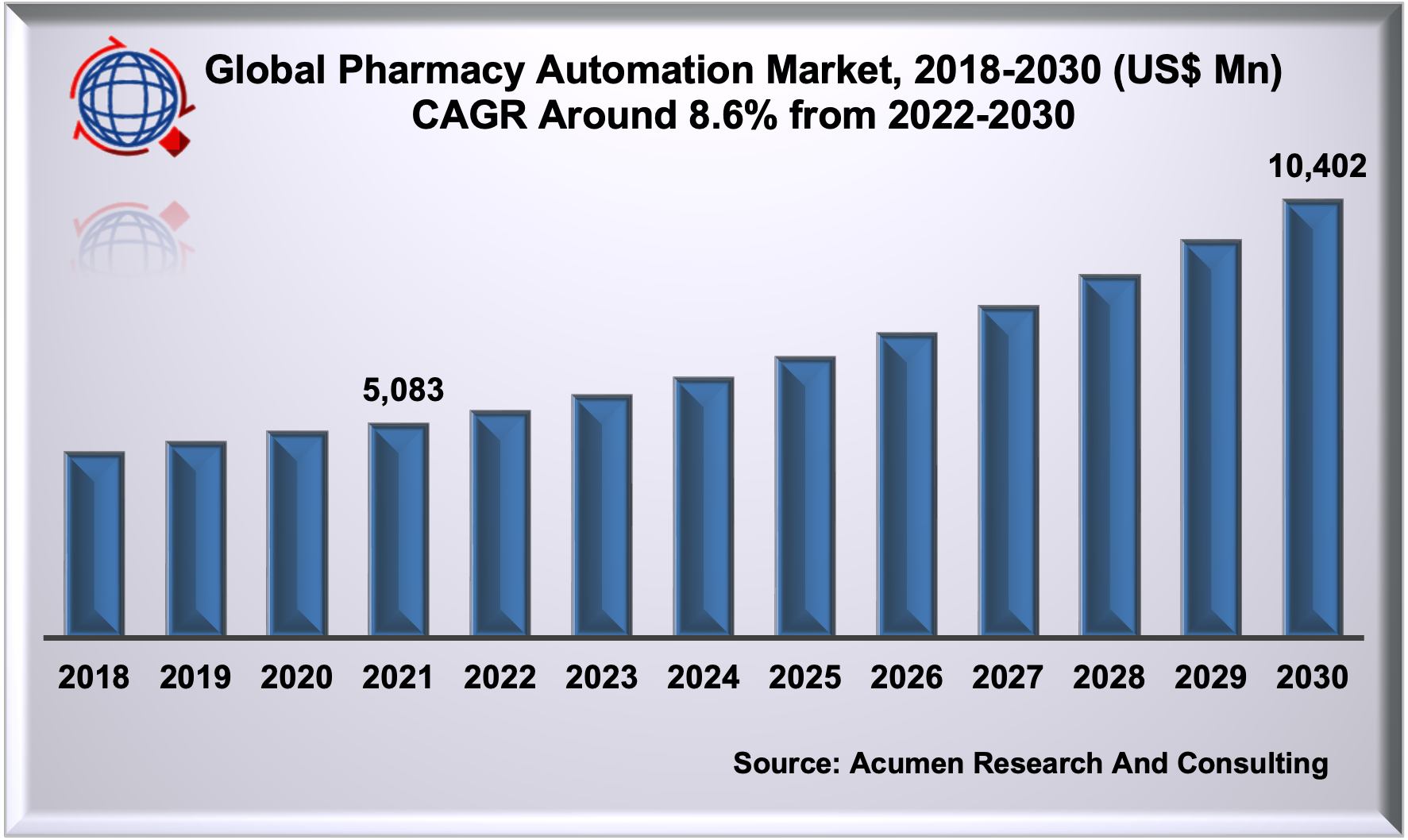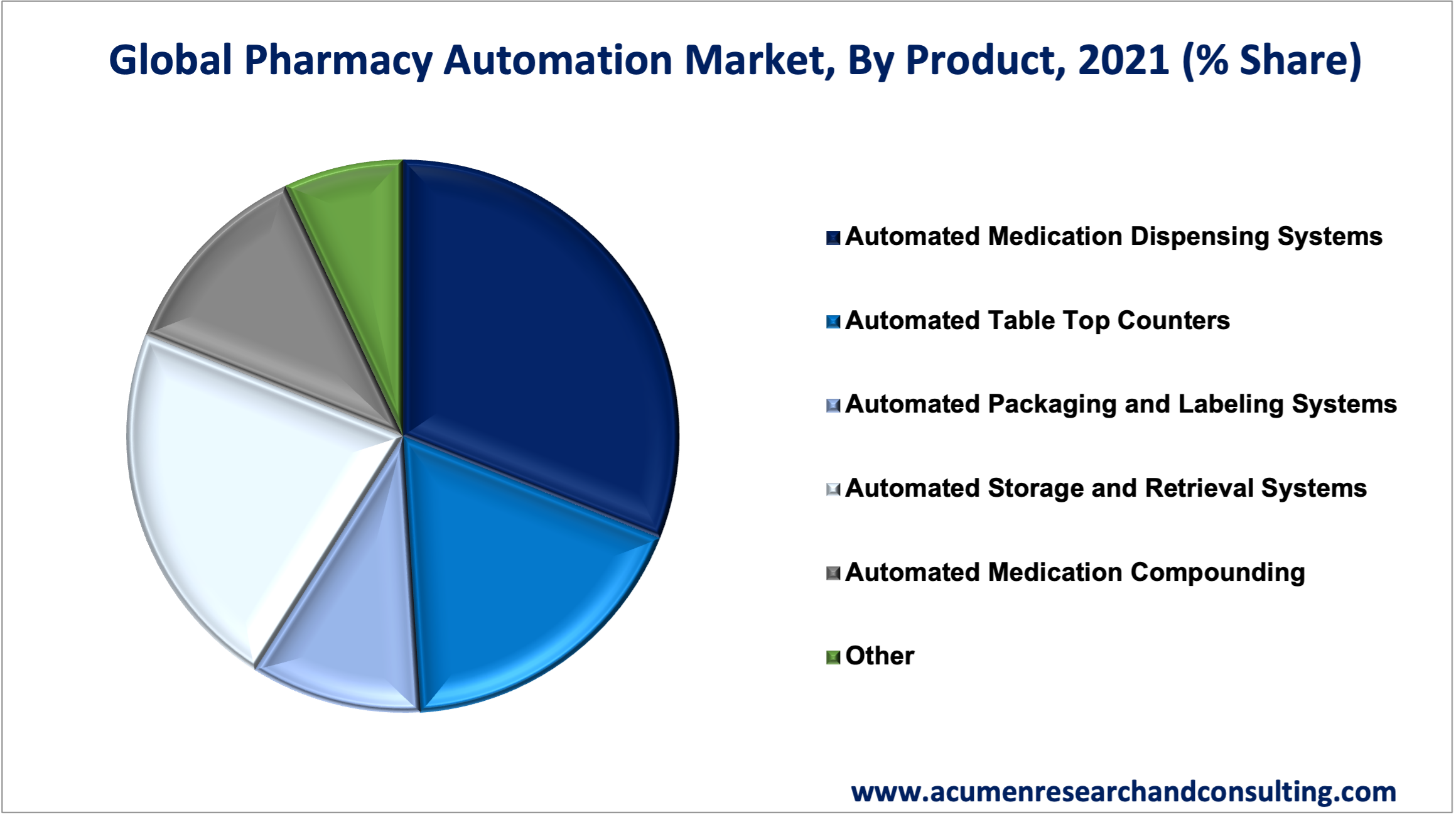December 2023
Pharmacy Automation Market is expected to reach US$ 10,402 Mn by 2030 with a considerable CAGR of 8.6%
The Global Pharmacy Automation Market size accounted for US$ 5,083 Mn in 2021 and is expected to reach US$ 10,402 Mn by 2030 with a considerable CAGR of 8.6% during the forecast timeframe of 2022 to 2030.
Pharmacy automation refers to the automated systems that are used to sort, package, distribute, and administer prescription drugs. This type of system enables pharmacies to increase efficiency and effectiveness while lowering the risk of medical errors. Among the benefits of such systems are increased prescription drug volume and efficiency. The pharmacy automation process includes increasing productivity, lowering labor costs, and improving accuracy. Furthermore, such systems have the potential to provide many advantages to pharmacy owners, such as improved drug safety, increased speed and accuracy, space savings, and excellent product management. Furthermore, one of the important aspects of the pharmaceutical sector is accuracy. Even the most knowledgeable or cautious individual can make errors. Many medications can cause negative side effects or even death if used incorrectly. However, implementing such a drug dosing system process greatly reduces the chance of error.

Drivers
· Rapidly increasing need to avoid dispensing errors
· Rising incidence of chronic diseases along with the geriatric population
· Increasing technological advancements in healthcare IT infrastructure
Restraints
· High capital investment and stringent informal guideline
· Reluctance to Adopt Pharmacy Automation Systems in emerging countries
Opportunity
· Increasing awareness among pharmacists
· Rising awareness and popularity in developing nations
Report Coverage
| Market | Pharmacy Automation Market |
| Market Size 2021 | US$ 5,083 Mn |
| Market Forecast 2030 | US$ 10,402 Mn |
| CAGR | 8.6% During 2022 - 2030 |
| Analysis Period | 2018 - 2030 |
| Base Year | 2021 |
| Forecast Data | 2022 - 2030 |
| Segments Covered | By Product, By End-Use, And By Geography |
| Regional Scope | North America, Europe, Asia Pacific, Latin America, and Middle East & Africa |
| Key Companies Profiled | Becton, Dickinson, and Company, ScriptPro LLC, Cerner Corporation, Omnicell, Inc., Capsa Healthcare, Baxter International, Inc., Parata Systems LLC, McKesson Corporation, RxSafe, LLC, Swisslog Healthcare, Talyst Systems, LLC, and ARxIUM Inc. |
| Report Coverage |
Market Trends, Drivers, Restraints, Competitive Analysis, Player Profiling, Regulation Analysis |
| Customization Scope |
10 hrs of free customization and expert consultation |
Pharmacy Automation Market Dynamics
Rising dispensing errors and increased adoption of smart medical services are the primary factors driving the market growth. The major factors driving the market growth are the growing need to eliminate errors in medical and clinical processes, as well as the decentralization of pharmacies. Even though pharmacy automation is incredibly adaptable and self-adaptive, it is becoming an essential component of the modern healthcare industry. For instance, automation systems prevent cross-contamination of medications by using separate storage cells and chutes, allowing for the monitoring of reference numbers and expiry dates with serial numbers for easy scanning and inventory control. Furthermore, various technological developments are leading to increased post-treatment and surgery success rates, as well as the delivery of an effective healthcare system, all of which are significantly contributing to market growth. However, problems with automated dispensing systems, such as frequent software upgrades and platform and infrastructure maintenance, are stifling market growth.
Pharmacy Automation Market Segmentation
Market by Product
· Automated Medication Dispensing Systems
· Automated Tabletop Counters
· Automated Packaging and Labeling Systems
· Automated Storage and Retrieval Systems
· Automated Medication Compounding
· Other

In terms of product, the automated medication dispensing system held the largest market share in 2021. The automated dispensing system, also known as automated drug cabinets, is a type of digital drug storage and distribution system that is widely used in healthcare settings. The rising number of deaths from dispensing and medication errors, combined with stringent government policies, is putting the burden on healthcare organizations and pharmacists to integrate various medication dispensing systems in order to improve patient care services. Automated medication dispensers are designed to help people manage pharmacy medicine needs with ease, safety, speed, reliability, and easy access to public services. Furthermore, the increasing prevalence of chronic diseases, as well as the world's aging population, are expected to drive demand for the automated medication dispensing system segment in the market over the next ten years.
Market by End-user
· Hospital Pharmacy
· Retail Pharmacy
Retail pharmacies are the fastest-growing end-user segment in the pharmacy automation market throughout the forecast period, owing to an increase in the number of retail pharmacies, an increase in the need to minimize dispensing errors, and an increased workload on pharmacists. Over the last few years, the total Asian retail pharmacy market has grown at an average annual rate of 18 percent, and it is expected to grow even faster in the future. Furthermore, the most common causes of the rise in the number of patients suffering from lifestyle-related illnesses are sedentary lifestyles, stress, and poor eating habits. This will begin to regulate medication on an ongoing basis, making prescription-based medicines mandatory, assisting in the global expansion of the retail pharmacy segment in the market.
Pharmacy Automation Market Regional Overview
North America
· U.S.
· Canada
Europe
· U.K.
· France
· Germany
· Spain
· Rest of Europe
Latin America
· Mexico
· Brazil
· Rest of Latin America
Asia-Pacific
· India
· China
· Japan
· Australia
· South Korea
· Rest of Asia-Pacific
Middle East & Africa
· South Africa
· GCC
· Rest of Middle East & Africa
According to the research study, North America accounted for the largest share of the global pharmacy automation market and is projected to continue to dominate overseas markets dynamics in the forecasted period. The growing geriatric populations, the need to reduce clinical errors, and the growing adoption of advanced technological products in healthcare systems are driving the growth of these markets. Furthermore, the region's well-established healthcare infrastructure, which has increased the number of prescribed drugs, is propelling the North American pharmacy automation market forward. The increased federal funding for the development of healthcare facilities has increased the demand for specialty medication administering techniques and services. Furthermore, advanced technologies in healthcare IT infrastructure to reduce dispensing errors, as well as an increase in demand for quality patient care in the United States, are expected to drive the pharmacy automation market. The growing pool of geriatric medicine and a focus on increasing healthcare management efficiency is also driving the regional market.
Competitive Landscape
Some of the prominent players in global pharmacy automation market are Becton, Dickinson, and Company, ScriptPro LLC, Cerner Corporation, Omnicell, Inc., Capsa Healthcare, Baxter International, Inc., Parata Systems LLC, McKesson Corporation, RxSafe, LLC, Swisslog Healthcare, Talyst Systems, LLC, and ARxIUM Inc.
Looking for discounts, bulk pricing, or custom solutions? Contact us today at sales@acumenresearchandconsulting.com
December 2023
February 2024
June 2022
June 2022